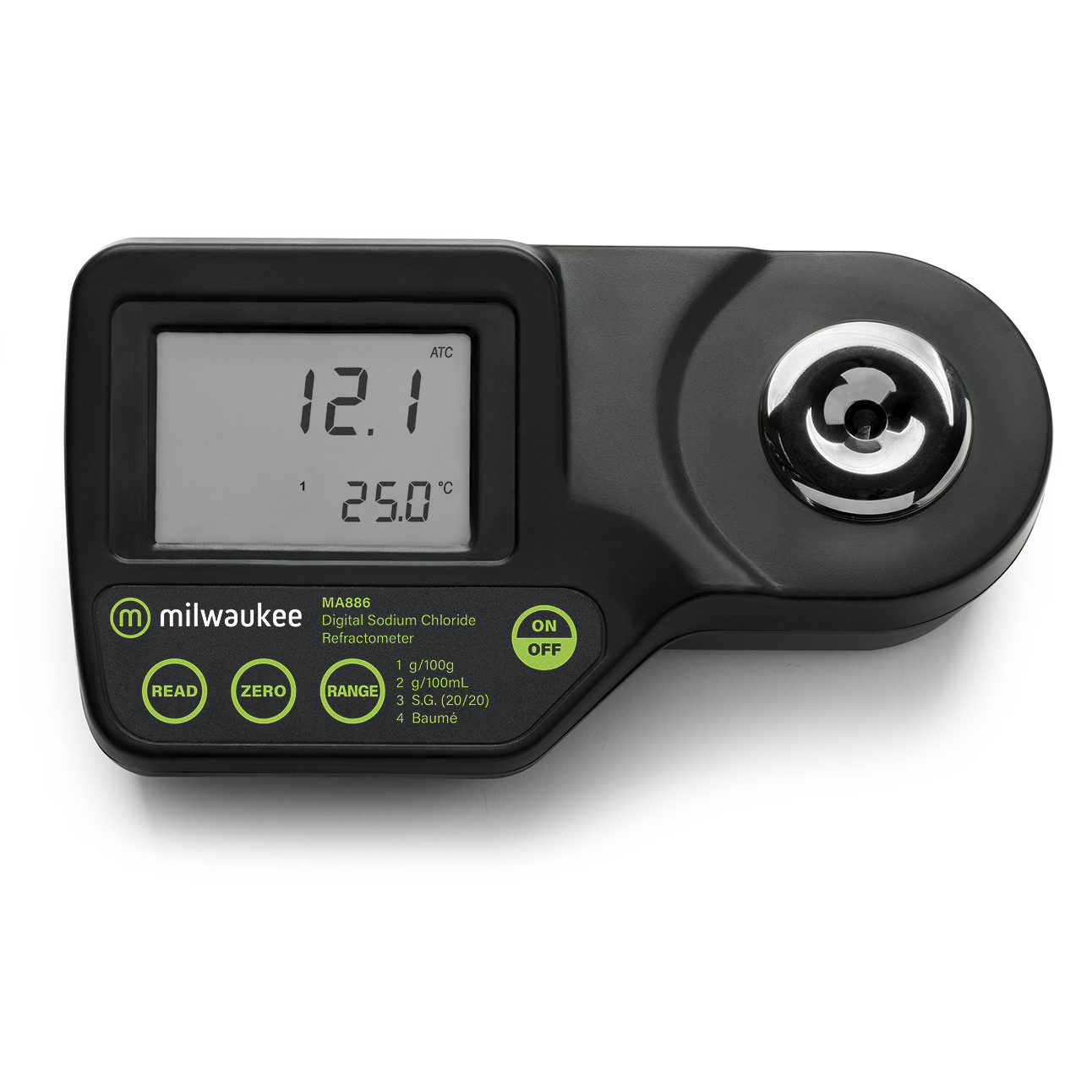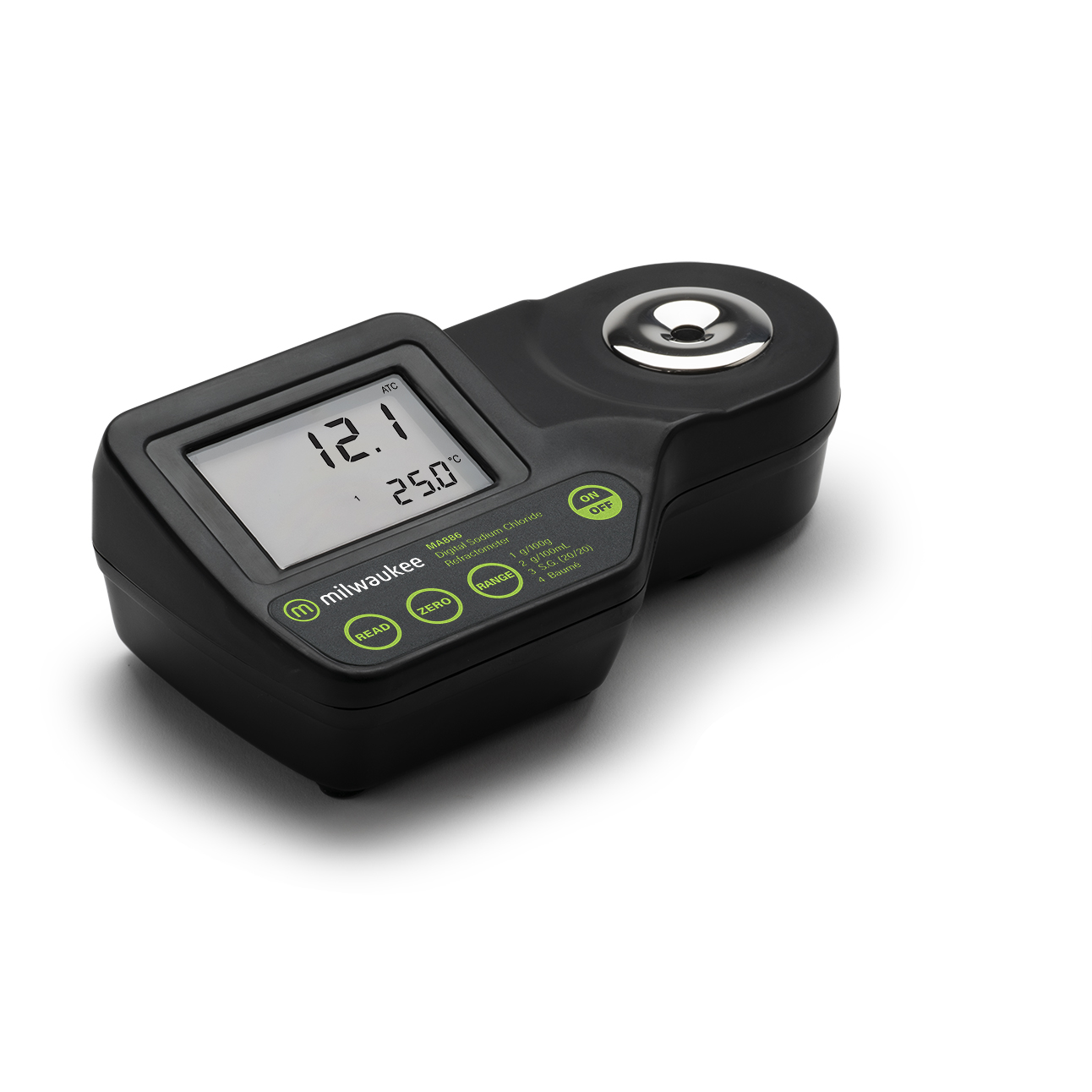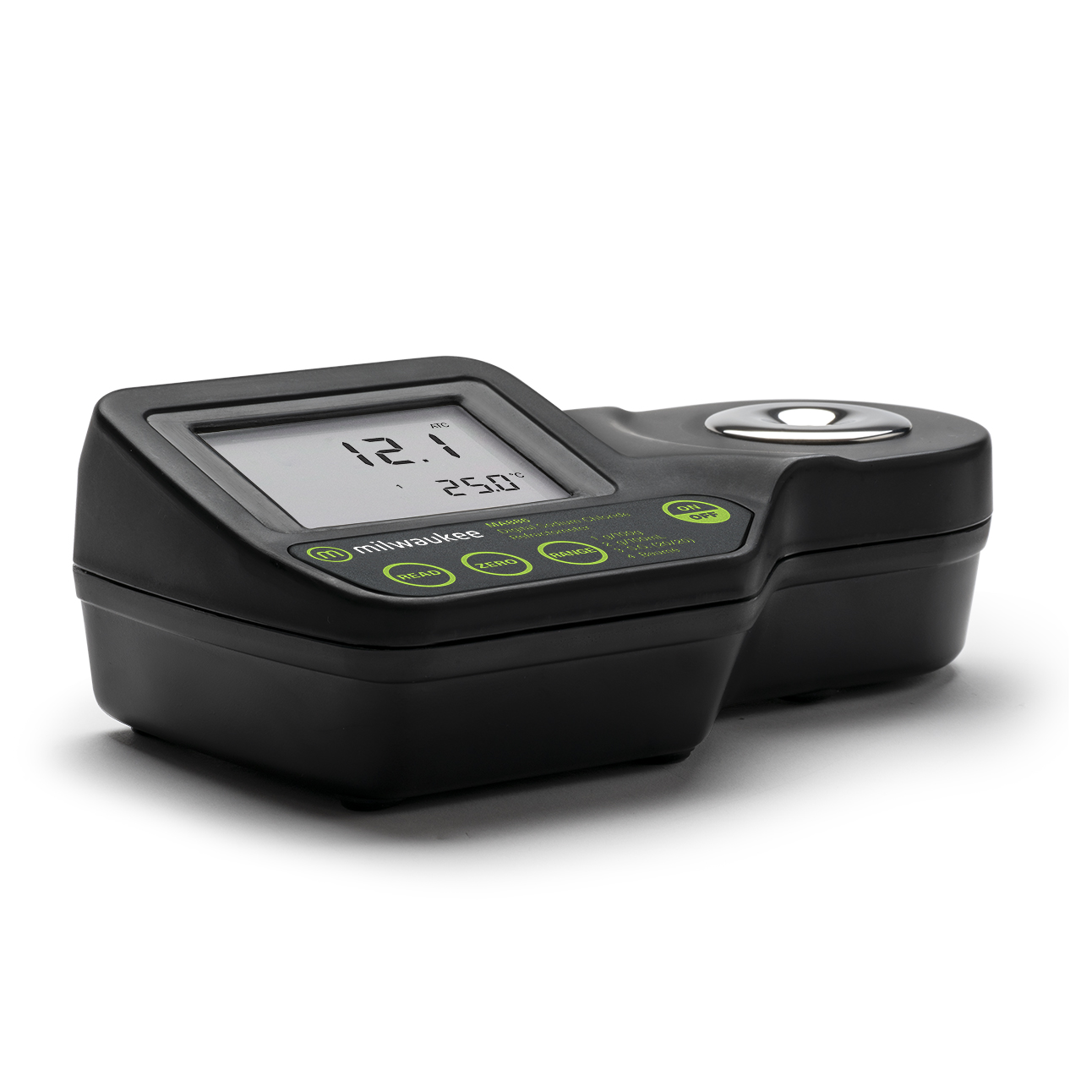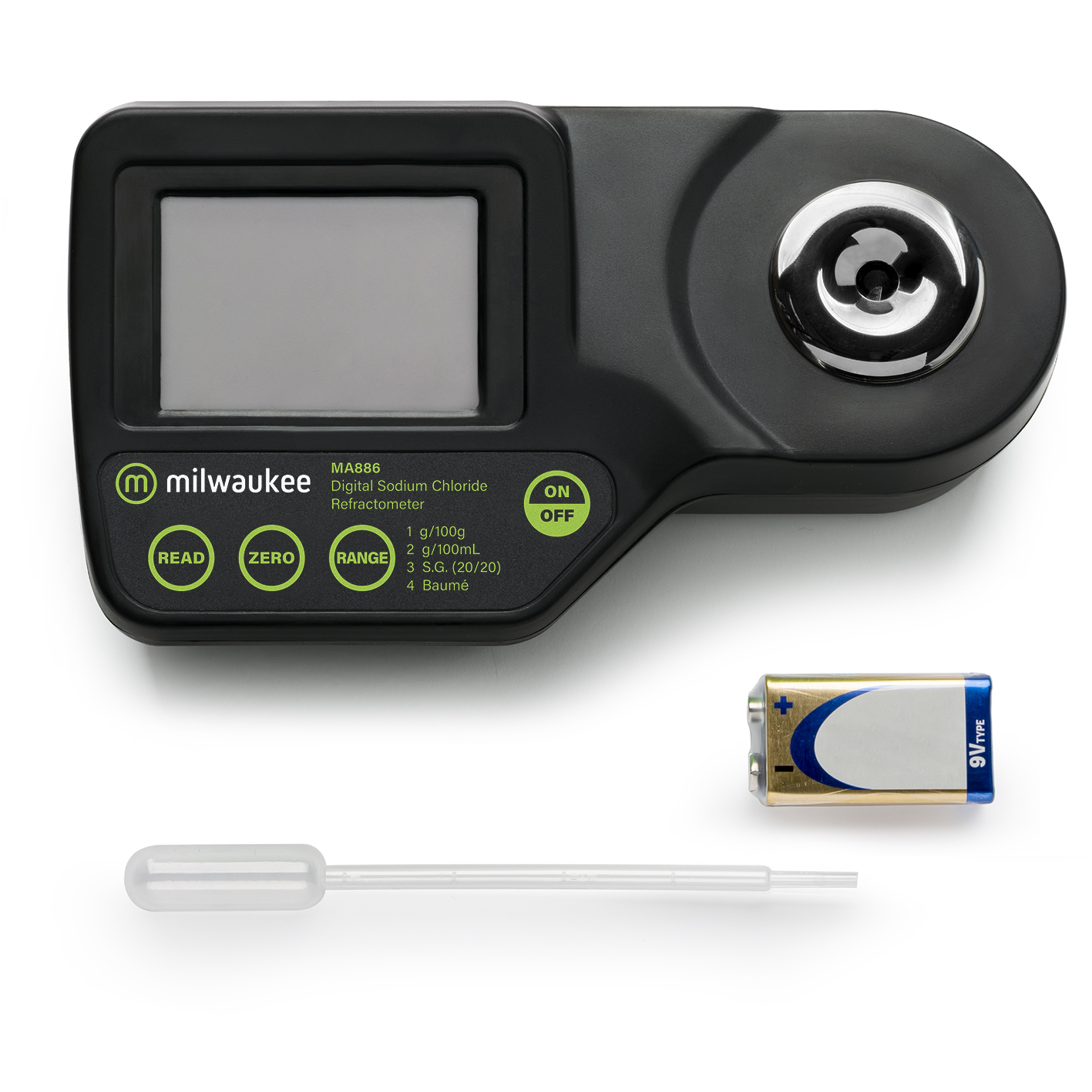Your shopping cart is currently empty.
€235.56
Milwaukee MA886 Digital Refractometer to Determine Sodium Chloride in Food
Milwaukee MA886 Digital Sodium Chloride Refractometer – Precision Salt Measurement for Food & Industry
A Smarter Way to Measure Sodium Chloride
In today’s food industry, salt plays more than just a flavoring role – it is a critical ingredient for preservation, safety, and product consistency. From pickling vegetables and curing meats to ensuring brine strength in cheese making, precise control of sodium chloride concentration is essential. The Milwaukee MA886 Digital Sodium Chloride Refractometer is designed to deliver fast, accurate, and reliable measurements in seconds, giving food professionals, researchers, and process engineers the confidence they need.
Unlike traditional optical refractometers that rely on subjective reading and ambient light conditions, the MA886 uses digital precision with automatic temperature compensation (ATC). This ensures accuracy and repeatability, eliminating guesswork and providing trustworthy results in any environment. Compact, portable, and easy to use, it brings lab-grade accuracy directly to production floors, kitchens, and quality control stations.
Note: MA886 is not intended for measuring salinity in sea or aquarium water (for that, Milwaukee offers the MA887).
Why Choose the Milwaukee MA886?
- High Accuracy: Measures sodium chloride concentrations from 0 to 28 g/100 g with an accuracy of ±0.001 refractive index.
- Versatile Readings: Displays results in multiple scales – g/100 g, g/100 mL, specific gravity, and refractive index – offering flexibility for different industries and applications.
- Automatic Temperature Compensation (ATC): Built-in compensation ensures precise results without the need for manual corrections, even in fluctuating environments.
- User-Friendly Digital Display: Clear LCD screen for quick, error-free readings compared to analog refractometers.
- Portable & Durable: Lightweight design makes it easy to carry between lab, kitchen, or factory floor. Designed with robust construction to withstand regular professional use.
- Quick & Reliable: Provides fast results in less than 2 seconds, helping you optimize workflows and maintain production efficiency.
Applications
The MA886 is widely trusted across industries that depend on precise sodium chloride concentration.
1. Food Industry & Processing
· Brine preparation for pickling, canning, and preserving.
· Salt level monitoring in cheese, cured meats, and fish processing.
· Quality control in sauces, soups, dressings, and ready-to-eat foods.
2. Industrial & Process Monitoring
· Brine strength measurement for water treatment and resin regeneration.
· Monitoring salt concentration in chemical and cleaning processes.
· Controlling NaCl solutions used in manufacturing.
3. Road & De-Icing Applications
· Checking the concentration of salt brines for road safety and winter treatments.
4. Laboratories & Research
· Food science research and product development.
· Preparation and verification of sodium chloride standard solutions.
· Educational demonstrations of refractometry and solution chemistry.
5. Environmental Monitoring
· Measuring salt levels in fresh water and groundwater studies (within the range of the instrument).
Proper Care & Maintenance
To keep your MA886 performing at its best, regular care is essential:
- Cleaning: After each use, rinse the sample well with distilled or deionized water and gently wipe with a soft cloth to avoid salt build-up or crystallization.
- Storage: Always store the refractometer in a clean, dry location. Avoid exposure to direct sunlight, dust, or high humidity.
- Calibration: Calibrate regularly with distilled water to ensure accuracy, especially after heavy use or if readings appear inconsistent.
- Sample Handling: Use clean pipettes or droppers to prevent contamination. Avoid leaving samples to dry on the prism surface, as this can leave residues that affect accuracy.
- Battery Maintenance: Replace batteries when the low-battery indicator appears to ensure stable performance.
With proper maintenance, the Milwaukee MA886 will provide years of reliable, precise sodium chloride measurements – making it an indispensable tool for professionals across food production, industrial processes, and laboratory environments.
Specifications
Application
Food Industry – Salt & Brine Concentration in Food Processing
Salt is one of the oldest and most reliable food preservatives in the world. In modern food processing, it is used not only to enhance flavor but also to extend shelf life, improve texture, and ensure food safety. From curing meats and fermenting vegetables to preparing brines for cheese or fish, the precise sodium chloride concentration directly affects product quality, consistency, and safety.
The Milwaukee MA886 Digital Sodium Chloride Refractometer is specifically designed to meet these needs. It allows food professionals to measure salt concentration in aqueous food solutions with unmatched accuracy, covering a range of 0 to 28 g/100 g. Unlike traditional optical refractometers, the MA886 provides digital readouts with automatic temperature compensation (ATC), eliminating errors caused by ambient conditions or subjective reading.
Why Salt Control Matters in Food Production
- Pickling & Fermentation: The right NaCl concentration is essential for creating an environment where beneficial bacteria thrive while harmful microbes are suppressed. This ensures safe, consistent fermentation in pickles, kimchi, and sauerkraut.
- Meat & Fish Curing: In cured meats (ham, bacon, sausages) and fish (smoked salmon, salted cod), salt concentration directly influences preservation, taste, and texture. The MA886 helps maintain consistent brine strength to meet strict food safety standards.
- Cheese Making: Salt affects moisture content, microbial balance, and flavor in cheese. Monitoring brine strength ensures uniform salting and avoids defects.
- Sauces, Soups & Processed Foods: In mass production, even small variations in salt levels can affect product taste, shelf stability, and regulatory compliance. The MA886 ensures accurate salt content, batch after batch.
⚠️ Important Note: The MA886 is designed for NaCl measurement in food-related aqueous solutions. It is not suitable for measuring salinity in seawater or aquariums. For those applications, Milwaukee Instruments offers the MA887 Seawater Digital Refractometer.
How to Use the MA886 in Food Applications
Using the MA886 is straightforward, making it ideal for both laboratory and production-floor settings:
1. Calibrate Before Use
Start by calibrating the instrument with distilled water. Simply place a drop of distilled water on the prism, press the calibration button, and the unit will automatically adjust. Regular calibration ensures long-term accuracy.
2. Prepare the Sample
Take a small liquid sample from your brine, marinade, soup, or other food solution. If the solution contains solid particles (herbs, seeds, spices), filter or let them settle before measurement for the best results.
3. Apply the Sample
Place 2–3 drops of the solution onto the measurement prism. Close the cover to spread the liquid evenly and avoid bubbles.
4. Take the Reading
Press the "Read" button. The sodium chloride concentration will appear on the clear digital LCD display in your chosen unit: g/100 g, g/100 mL, specific gravity, or refractive index.
5. Interpret & Record
Compare the result against your recipe specification, HACCP plan, or regulatory requirement. Adjust the process if needed (for example, diluting a brine or adding more salt).
6. Clean After Use
Rinse the prism with distilled water and gently wipe it dry with a soft cloth. This prevents salt crystal build-up and keeps the refractometer accurate for the next test.
Laboratory & Analytical Use – Accurate NaCl Analysis for Food Science and Research
In laboratories, accuracy and repeatability are non-negotiable. Whether it’s a food science lab, a quality control department, or an academic research facility, the ability to measure sodium chloride (NaCl) concentration quickly and precisely can save time, reduce costs, and improve reliability. Traditional methods like titration or gravimetric analysis are effective but often labor-intensive, requiring multiple steps, chemical reagents, and extended analysis time.
The Milwaukee MA886 Digital Sodium Chloride Refractometer offers a fast, clean, and reliable alternative for NaCl concentration measurement in aqueous solutions. With a measurement range of 0 to 28 g/100 g, and accuracy supported by Automatic Temperature Compensation (ATC), the MA886 is ideally suited for:
- Food Science Laboratories: Rapid testing of brines, soups, sauces, and processed food extracts to ensure formulations match target specifications.
- Research Laboratories: Conducting controlled experiments where precise salt concentration is critical – for example, in osmotic studies, microbial growth research, or diffusion experiments.
- Quality Control in Industry Labs: Serving as a quick-screening tool to confirm batch consistency before performing more time-consuming or destructive testing methods.
- Calibration and Validation: The MA886 can be used as a reference instrument for preparing or verifying standard sodium chloride solutions, making it an essential part of laboratory calibration workflows.
By providing rapid, digital results in less than two seconds, the MA886 helps laboratories save time while maintaining the accuracy and reliability required for scientific and industrial applications.
Why the MA886 is Valuable for Labs
- High-accuracy sodium chloride testing without chemical reagents.
- Non-destructive analysis – requires only a couple of drops of sample.
- Digital precision eliminates the subjectivity of analog refractometers.
- Multiple measurement scales (g/100 g, g/100 mL, specific gravity, refractive index) offer flexibility for different experimental protocols.
- Portable design allows use both in the lab and in field research studies.
How to Use the MA886 in Laboratory Settings
1. Instrument Calibration
Begin by calibrating with distilled or deionized water. Place a few drops on the prism, press the calibration button, and the MA886 automatically adjusts. Regular calibration guarantees traceable accuracy, which is vital in lab work.
2. Sample Preparation
Collect a small representative sample of your solution. For reproducibility, ensure it is well mixed and free of bubbles or undissolved solids that may affect the reading.
If the solution contains particulates (e.g., food extracts), filtering through fine mesh or paper may improve measurement consistency.
3. Measurement
Place 2–3 drops of the solution onto the prism surface. Close the cover plate to spread the sample evenly.
Press the Read button. The digital display will show the NaCl concentration instantly in the chosen measurement unit.
4. Data Recording & Analysis
Record the results as part of your lab notebook, HACCP documentation, or research protocol.
If further validation is required, use the MA886 measurement as a reference point before performing titration or other analytical methods.
5. Post-Measurement Care
After each test, rinse the prism thoroughly with distilled water. Wipe gently with a lint-free cloth to prevent salt deposits that could skew future results.
Industrial & Process Monitoring – Reliable NaCl Control in Brine Systems
In industrial environments, precise sodium chloride concentration monitoring is critical for efficiency, safety, and cost control. Salt brines are widely used in chemical plants, desalination systems, cooling processes, and water treatment facilities, where even small fluctuations in concentration can impact performance, product quality, and equipment lifespan.
The Milwaukee MA886 Digital Sodium Chloride Refractometer provides a fast, accurate, and easy-to-use solution for monitoring NaCl levels in industrial brine solutions. With its measurement range of 0 to 28 g/100 g and automatic temperature compensation (ATC), it ensures reliable results across different industrial environments – from high-temperature process lines to field testing.
Key Industrial Applications
· Chemical Plants & Manufacturing
Monitoring sodium chloride levels in solutions used for chemical reactions, formulations, and cleaning systems.
Ensuring correct salt balance during mixing, dilution, and evaporation steps.
· Desalination & Salt Production
Measuring the concentration of saltwater brines during evaporation and crystallization stages.
Optimizing salt extraction processes by maintaining target NaCl levels.
· Water Treatment Plants
Checking brine strength used in ion exchange resin regeneration (softening systems).
Monitoring NaCl levels to ensure efficiency in reverse osmosis pre-treatment systems.
· Cooling & Cleaning Systems
Measuring brine concentration in industrial cooling systems to prevent under- or over-salting.
Ensuring consistency in salt-based cleaning and sterilization processes.
With its digital precision, portable design, and ease of use, the MA886 gives engineers and operators a reliable tool to keep processes optimized and avoid costly errors.
Why the MA886 is Ideal for Industrial Use
- Fast and precise measurements allow real-time process adjustments.
- Digital readout eliminates human error common in optical refractometers.
- Durable construction withstands frequent testing in demanding industrial environments.
- Multi-scale results (g/100 g, g/100 mL, specific gravity, refractive index) give operators flexibility depending on their process requirements.
- Minimal sample size required – just a few drops to get accurate readings.
How to Use the MA886 in Industrial Applications
- Calibrate Before Testing
- Always calibrate the refractometer with distilled water at the start of a shift. This ensures traceable and reproducible results in compliance with industrial QA standards.
- Collect a Brine Sample
- Take a representative sample from the process line, tank, or brine system. Ensure the solution is free from oils, solids, or contaminants that may interfere with the reading.
- Load the Sample
- Place 2–3 drops on the prism surface. Close the cover to distribute the sample evenly and remove air bubbles.
- Measure
- Press the Read button. The digital LCD will display the sodium chloride concentration instantly in your selected measurement unit.
- Adjust the Process
- Compare the reading with the target concentration. Adjust dilution (adding water) or concentration (via evaporation or salt addition) as needed to keep the process within specification.
- Clean and Maintain
- After each use, rinse the prism with distilled water and wipe gently. This prevents salt build-up that could affect future readings.
Quality Control in Chemical & Materials Manufacturing – Precision Salt Concentration Monitoring
In chemical production and materials manufacturing, the consistency of raw materials and process solutions directly impacts product quality, efficiency, and compliance. Sodium chloride (NaCl) is widely used as a reagent, additive, or supporting chemical in various industries. It plays a critical role in electroplating, buffer preparation, coatings, and cleaning solutions, where precise concentration levels must be maintained to ensure reliability, performance, and safety.
The Milwaukee MA886 Digital Sodium Chloride Refractometer provides a fast, accurate, and digital method for NaCl concentration monitoring across a wide range of manufacturing processes. Unlike traditional wet-chemistry methods that require reagents and long analysis times, the MA886 delivers instant results with just a few drops of sample, making it ideal for on-site quality control and process verification.
Key Use Cases in Manufacturing
· Electroplating Baths
Monitoring NaCl concentration in plating solutions to ensure proper conductivity, deposition rate, and coating quality.
Preventing defects such as uneven thickness, poor adhesion, or surface contamination caused by incorrect brine balance.
· Buffer Solutions & Reagents
Verifying the sodium chloride concentration in buffer systems used in chemical production, biotechnology, and laboratory applications.
Maintaining accuracy in processes that depend on precise ionic strength for stability and reactivity.
· Coatings, Cleaning & Surface Treatments
Controlling the strength of salt solutions used in industrial cleaning baths, degreasing, or pre-treatment stages before coating.
Ensuring consistency in salt-based chemical formulations for paints, coatings, and protective finishes.
· Salt-Based Manufacturing Processes
Used in industries where salt brines are part of the raw material feedstock or production chemistry, requiring tight quality assurance to avoid costly errors or rework.
By offering digital accuracy with automatic temperature compensation (ATC), the MA886 helps manufacturers achieve consistent product quality, reduced waste, and better process efficiency.
Why the MA886 is a Quality Control Essential
- Accurate NaCl measurement across a wide range (0–28 g/100 g) for diverse industrial solutions.
- Fast analysis in under 2 seconds, eliminating bottlenecks in production QA.
- Digital precision reduces operator subjectivity compared to optical refractometers.
- Portable and durable design makes it suitable for both lab QC and shop-floor verification.
- Cost-effective alternative to time-consuming titration or wet-chemistry methods.
How to Use the MA886 in Manufacturing Quality Control
1. Calibration
Start by calibrating with distilled water to ensure traceable accuracy. Regular calibration is recommended for compliance with ISO, GMP, or HACCP quality standards.
2. Sample Collection
Take a small sample of the electroplating bath, buffer solution, or chemical brine. Ensure the sample is representative and free of air bubbles or large particulates.
3. Loading the Prism
Place 2–3 drops of the solution on the measurement prism and close the cover to spread it evenly.
4. Measurement
Press the Read button. The display will show the sodium chloride concentration instantly in the selected measurement unit (g/100 g, g/100 mL, specific gravity, or refractive index).
5. Evaluate & Adjust
Compare the reading against your process specifications. Adjust the solution by adding salt, water, or reagents as required to bring the concentration into compliance.
6. Post-Use Cleaning
Rinse the prism with distilled water after each test to prevent salt crystallization or chemical residues that may affect future accuracy.
Road & De-icing Applications – Ensuring Safe and Effective Brine Solutions
During winter, salt brines are one of the most cost-effective and widely used solutions for road de-icing and anti-icing. The concentration of sodium chloride in these brines directly determines how effectively they lower the freezing point of water, preventing ice formation and improving road safety. If the brine is too diluted, it won’t work effectively; if it’s too concentrated, it may waste material, cause unnecessary corrosion, and increase costs.
The Milwaukee MA886 Digital Sodium Chloride Refractometer provides a fast and reliable method for checking salt brine concentration used in road maintenance, winter service operations, and municipal de-icing programs. With its digital display, automatic temperature compensation (ATC), and wide measurement range (0–28 g/100 g), it allows operators to prepare, verify, and adjust brine solutions with confidence before they are applied to roads.
Key Use Cases in Road & De-icing
- Anti-icing Preparation: Measuring brine solutions before application to ensure optimal concentration for preventing ice formation.
- De-icing Efficiency: Checking field samples of applied brine to verify effectiveness in active road treatment.
- Cost & Resource Optimization: Avoiding excess salt usage by maintaining brine at the correct concentration.
- Corrosion Control: Preventing overly strong brines that may damage vehicles, road surfaces, and infrastructure.
How to Use the MA886 for Road Brine Testing
1. Calibrate the Instrument
Calibrate with distilled water before starting measurements to ensure accuracy.
2. Take a Brine Sample
Collect a small amount of brine from the mixing tank, storage container, or directly from spray equipment.
3. Load the Prism
Place 2–3 drops of brine solution onto the prism, close the cover, and ensure no bubbles are trapped.
4. Measure
Press the Read button. The digital display will show the sodium chloride concentration instantly.
5. Adjust as Needed
If the reading falls outside the desired concentration (commonly around 23.3% NaCl for freezing point optimization), adjust by adding salt or water.
6. Clean the Instrument
Rinse the prism with distilled water after each measurement to prevent salt build-up.
Environmental Monitoring – Tracking Salinity and Sodium Chloride in Water
In environmental science, hydrology, and ecological monitoring, measuring salt concentration in water is essential for assessing water quality, detecting contamination, and studying ecosystem changes. Sodium chloride levels affect aquatic life, soil health, and groundwater balance, making precise measurement a key tool in both research and conservation efforts.
The Milwaukee MA886 Digital Sodium Chloride Refractometer offers scientists, educators, and environmental monitoring professionals a simple yet powerful tool for tracking NaCl levels in freshwater systems, groundwater, rivers, and lakes within its measurement range of 0 to 28 g/100 g. Its digital accuracy, portability, and automatic temperature compensation (ATC) make it especially valuable for field research and educational demonstrations.
Key Environmental Applications
- Water Quality Monitoring: Detecting salt intrusion in freshwater systems, groundwater, or agricultural irrigation sources.
- Pollution Studies: Measuring elevated NaCl levels due to runoff from roads, industrial activity, or urban wastewater.
- Ecosystem Health: Assessing the effects of salt on aquatic species, plants, and soil conditions.
- Education & Research: Teaching principles of salinity, refractometry, and solution chemistry in schools and universities.
⚠️ Note: The MA886 is designed for sodium chloride solutions and is not suitable for seawater salinity measurement. For marine and aquarium use, Milwaukee Instruments recommends the MA887 Seawater Refractometer.
How to Use the MA886 in Environmental Monitoring
1. Calibrate the Refractometer
Use distilled water for calibration before taking field or lab measurements.
2. Collect the Water Sample
Take a representative sample from the river, lake, groundwater source, or runoff site. Remove particulates if necessary to ensure clarity.
3. Apply the Sample
Place a few drops on the prism, close the cover, and spread the liquid evenly.
4. Read the Results
Press the Read button to instantly view the sodium chloride concentration.
5. Record & Compare
Document the reading for environmental tracking, research records, or compliance reports. Compare with baseline or regulatory standards.
6. Care After Use
Rinse with distilled water and dry gently to prevent contamination between different field sites.
Educational & Teaching Applications – Bringing Refractometry to the Classroom
In science education, the most effective learning happens when theory meets practice. The Milwaukee MA886 Digital Sodium Chloride Refractometer is an excellent teaching tool for schools, universities, and technical training programs because it transforms abstract concepts into hands-on learning experiences. By using the MA886 in chemistry labs, food science classes, or environmental studies programs, students can directly observe how sodium chloride concentration, refractive index, and temperature compensation interact in real-world measurements.
This instrument allows instructors to demonstrate key analytical chemistry principles, such as:
- Refractometry Basics: How light bends when passing through solutions of different concentrations.
- Concentration Measurement: Linking refractive index to sodium chloride concentration in food or industrial samples.
- Calibration Practices: Showing students the importance of calibration in ensuring measurement accuracy.
- Automatic Temperature Compensation (ATC): Demonstrating how modern instruments correct for environmental fluctuations, ensuring precise results.
- Analytical Methods: Reinforcing the role of digital refractometers in laboratories compared to traditional titration or gravimetric analysis.
By incorporating the MA886 into lab sessions, educators can create engaging, real-world lessons that prepare students for professional roles in food technology, chemistry, environmental science, and industrial quality control.
Why the MA886 is Ideal for Education
- User-friendly digital interface makes it accessible for students at all levels.
- Instant results encourage interactive learning and immediate discussion.
- Low sample volume requirement (just 2–3 drops) makes it cost-effective for repeated demonstrations.
- Versatility allows it to be used in chemistry, food science, biology, and environmental studies labs.
- Durable and portable design supports both classroom and field demonstrations.
How to Use the MA886 in Educational Settings
1. Calibration Demonstration
Begin by calibrating the refractometer with distilled water. Show students how calibration ensures accuracy and why it’s critical in analytical chemistry.
2. Sample Preparation
Have students prepare sodium chloride solutions of known concentrations (e.g., 5%, 10%, 20%) to compare refractive index values.
3. Measurement Activity
Students place a few drops of each solution on the prism and record the digital NaCl concentration displayed.
Encourage them to compare results across units (g/100 g, g/100 mL, specific gravity, refractive index).
4. Temperature Compensation Exercise
Conduct the same measurement with solutions at different temperatures. Show how ATC stabilizes results, reinforcing why modern refractometers are essential for reliable data.
5. Data Recording & Analysis
Students record results, plot graphs of concentration vs refractive index, and discuss real-world implications (e.g., food preservation, industrial brines).
6. Care & Cleaning
Teach students proper cleaning and storage to maintain accuracy and extend the instrument’s life, building good laboratory habits.






